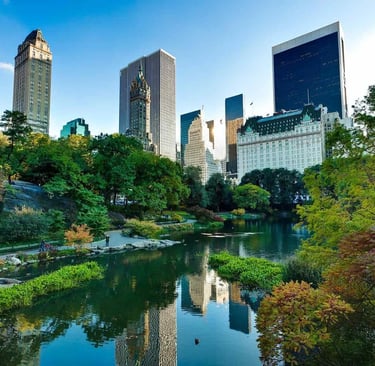How Cities are Becoming More Sustainable
ENVIRONMENTAL ISSUES
Danny Xu
10/17/20254 min read


Historically, cities have been considered as centers of pollution, overcrowding, and waste production. Nevertheless, lots of urban areas all over the globe are making a serious effort to change their reputation. Instead of being the main factor of the environmental crisis, cities are becoming areas of green projects that cut emissions, save resources, and improve the inhabitants' quality of life.
Greener Transportation
One of the main reasons for global warming is that cities burn a lot of fossil fuels in the transportation area and factories, and so this is where most of the moves of the governments are concentrated. The development of safe and comfortable bike lanes and footpaths, provide the citizens of urban areas the opportunity to leave the car at home. With the advancement of bus and train electrification, public transport is more clean and reduces the usage of harmful fossil fuels in metros. For now in some towns, there are also such small-scale transportation facilities as electric scooters and car-sharing services which are making the last distance problems easier without causing congestion. In fact, cities like Amsterdam and Copenhagen are the ultimate examples of what's feasible, where there are even more bikes than cars, and riding is a completely natural and daily activity.
Urban Green Spaces
Adding green spaces to the city is no longer viewed as a luxury but as a necessity. Parks, roof gardens, and trees along the streets are indispensable not only in terms of striking down the city heat, but also providing shelter, keeping the air cool and refreshing. Green areas that are full of plants can also draw up pollutants and provide the people who live there with clean, allergy-free air in return. Green spaces also encourage a number of animals to come and live there which in turn benefits the bees, the birds and the rest of the wildlife that find it hard to survive in cities without trees and plants.
Smarter Waste Management
Living in a city comes with waste problems that have been hard to solve over the years but by adopting strategies that think outside of the box, these problems are gradually becoming opportunities. More than half of the cities in the world have already taken a step toward the future by adopting composting plans that change food leftovers into nutrients that could be used in gardens and farms. Recycling has grown bigger due to the increase in the number of programs that have been launched all around the world; more and more people and businesses are taking the segregation of waste into their hands, and there are some parts where tax systems have been created to reward the inhabitants who create less garbage. They have also been careful to build waste-to-energy plants in the advanced cities that grab the junk from landfills and change it into electricity San Francisco is one of the cleanest cities as it has each of its various administrations adopting policies such as recycling, composting, among other practices that have led to more than 80% of the waste of the city being diverted to landfills as well as recycling.
Clean Energy and Efficiency
Besides urban lifestyles, cities are also going green in an impressive manner and also in more efficient ways to energy their buildings and neighborhoods. Schools, libraries, and other public buildings are also getting solar panels installed, resulting in cut costs as well as low emissions. Inefficient and old buildings are being renovated with new insulation, modern heating systems, and energy-efficient lighting, which leads to energy and money savings. At the same time, many cities are regulating laws to guarantee that new developments will be in compliance with strict environmental standards. For instance, New York City has established very ambitious targets that make it a requirement for big buildings to reduce emissions drastically by 2030. These transformations are not only coming soon as they are already changing skylines the world over.
Community Involvement
One of the most significant contributors to the development of sustainable cities may be the citizens themselves, who currently reside there. Governments and organizations see that the real change comes only when the residents are involved. Involvements such as neighborhood clean-ups, community gardens, and urban farming projects have multiplied and thus given people a feeling of ownership of their environments. Local businesses that focus on green activities are getting the support of environmentally conscious consumers who want their money to reflect their values. Such a bottom-up approach guarantees that sustainability is not just a policy that is passed down from the top but is a movement shared by all.
The Path Forward
The majority of people will live in cities in 2050 as the world's population continues to grow. Urban sustainability is the only way out in this reality. It is vital not only for mankind but for the whole planet as well. Citizens are becoming green rapidly in all aspects of life, from eco-friendly means of transportation and energy efficiency to better waste management and community-led projects. The change is a long way from being over, yet the progress we are privileged to witness today is the source of optimism: if our cities are capable of transformation, our future can be likewise. Through urban areas, daring tactics with regard to mobility, construction, and socializing are becoming evident, that the green lifestyle is not only achievable by a few but is rather accessible to all city dwellers.
Sources:
Brandofino, Stephen. 2024. “Learn Why San Francisco Was Voted No. 1 Overall on Clean Energy Survey from GovPilot.” Govpilot.com. GovPilot. June 5, 2024. https://www.govpilot.com/blog/learn-why-san-francisco-was-voted-no.-1-overall-on-clean-energy-survey-from-govpilot.
illuminem. 2023. “From Cars to Sustainable Transport: 10 Cities Leading the Way.” Illuminem.com. illuminem. March 23, 2023. https://illuminem.com/illuminemvoices/from-cars-to-sustainable-transport-10-cities-leading-the-way.
Mair, Callum. 2020. “City Life: Why Are Green Spaces Important?” Www.nhm.ac.uk. Natural History Museum. 2020. https://www.nhm.ac.uk/discover/why-we-need-green-spaces-in-cities.html.
“Sustainable Cities.” n.d. Www.nrdc.org. https://www.nrdc.org/issues/sustainable-cities#solutions.
